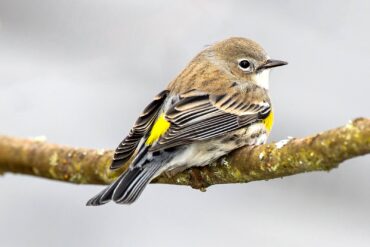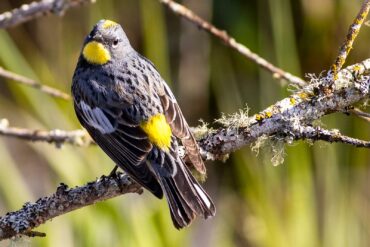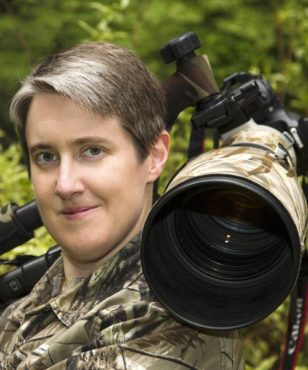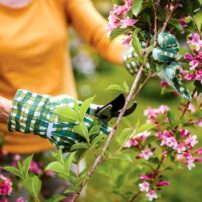
Springtime means birdsong. As frosty mornings give way to budding leaves, singing songbirds are a harbinger of winter’s departure and the arrival of spring. Year-round species such as American robins, Pacific wrens and song sparrows are among the first to belt out their melodic songs.
From March to May, migratory songbirds arrive in West Sound and use their songs to quickly establish breeding territories. Members of the warbler family are among the migrants that birders seek the most.
Most warbler species are migratory and nearly all have various amounts of yellow in their plumage. The small, endearing songbirds are named for the warbling melody sung by many warbler species.
There are 112 different warblers in the Americas, 53 of which breed in North America. Not counting rarities, 13 are regularly found in Washington each year, with eight breeding annually around West Sound. Although they are more abundant in spring and summer, three local warblers are present year-round: yellow-rumped, Townsend’s and orange-crowned warblers.
The yellow-rumped warbler is one of the most widespread warblers of North America. Its breeding range extends from Alaska to Nova Scotia and throughout much of the western United States. Some migrate short distances for the winter, going from the mountains to the coast. Northern breeders are long-distance migrants that winter in the eastern and southern United States, Mexico, the Caribbean and Central America.

In early spring, yellow-rumped warblers are ubiquitous. Males don crisp breeding plumage, showing off steel-blue feathers, accented by black-and-white flecks and mostly white bellies. Females and nonbreeding males are grayish tan. All have yellow sides and a trademark yellow rump for which they are named. Because of this, birders affectionately call them “butter butts.”
In West Sound, two yellow-rumped warbler subspecies are present. The easiest way to differentiate them is to look at the throat color. The more prevalent Audubon’s subspecies has a yellow throat and the less common Myrtle subspecies has a white throat. Both male and female Audubon’s subspecies have yellow stripes on the crown, as do male Myrtles.
The yellow-rumped warbler utilizes diverse habitat, depending on the region where it lives. Breeding occurs in mature conifers and mixed woodlands of coniferous and deciduous trees, often in the mountains. In the Pacific Northwest, breeding occurs in any coniferous forest, all the way to sea level. Those that are in migration or winter in the United States use a variety of habitat, particularly open woodlands with berry bushes. And, of course, there are many that winter in the tropics.
The yellow-rumped warbler can forage almost anywhere, making it perhaps the most versatile warbler. For most months of the year, insects make up the bulk of its diet.
These energetic and agile little songbirds can glean insects from almost any place. They can capture flying insects in midair. They can snatch up crawling insects, spiders and larvae from tree branches, leaves, the ground or even the surface of water.
Unique among warblers with its ability to digest bayberry, wax myrtle and other berries, the yellow-rumped warbler relies on fruit in winter when fewer insects are readily available. The diet is supplemented with seeds. Thus, this species can winter farther north than any other warbler.
Flocks can be large or small, with males usually foraging higher in the trees than females. In winter, yellow-rumped warblers sometimes join mixed flocks of roving songbirds. In early spring, they prefer forest edges. Trees in parks and shrubbery around wetlands are good places to look for close views of this vibrant little bird.
The yellow-rumped warbler usually nests in conifers, particularly fir trees, and sometimes uses deciduous trees. The female builds the small cup of twigs, pine needles, moss and grass on a horizontal branch between 4 and 50 feet off the ground. The nest measures 3 to 4 inches across and 2 inches deep and takes about 10 days to construct.
The female incubates the clutch of four or five eggs for almost two weeks. During this time, the male brings her food. Both parents care for the young.
Ten to 14 days after hatching, the nestlings are ready to fledge. The male continues tending to them for another fortnight before they are independent. Fledglings are capable of short flights a few days after leaving the nest.
Populations of this common warbler appear to be stable. While other bird species are in steep decline, the yellow-rumped warbler has increased its Washington population over the past 50 years. But like other migratory songbirds, the yellow-rumped warbler is highly susceptible to fatal collisions with skyscrapers and other man-made structures.
Springtime is fun for birdwatching. Beginners and experienced birders alike delight in the yellow-rumped warbler. Adding a splash of color to an awakening landscape, this bright little bird can provide a moment of joy and contentment to anyone’s day.





























Comments